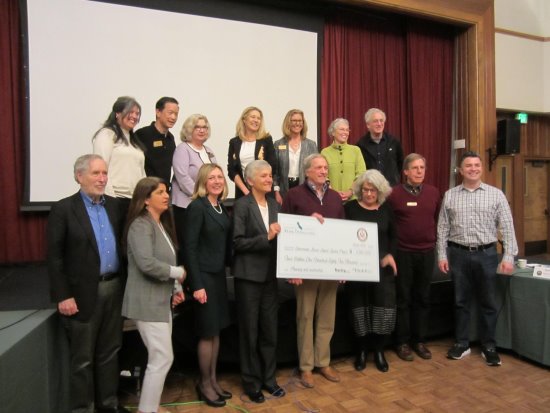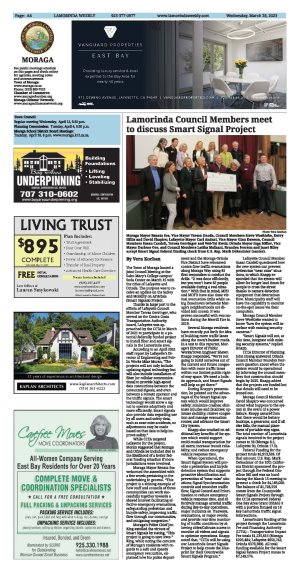| | Published March 29th, 2023
| Lamorinda Council Members meet to discuss Smart Signal Project
| | | By Vera Kochan |  | | Moraga Mayor Renata Sos, Vice Mayor Teresa Onoda, Council Members Steve Woehleke, Kerry Hillis and David Shapiro; Lafayette Mayor Carl Anduri, Vice Mayor Gina Dawson, Council Members Susan Candell, Teresa Gerringer and Wei-Tai Kwok; Orinda Mayor Inga Miller, Vice Mayor Darlene Gee, and Council Members Latika Malkani, Brandyn Iverson and Janet Riley accept Smart Signal federal funding check from U.S. Rep. Mark DeSaulnier (center). Photo Vera Kochan |
The Town of Moraga hosted a Joint Council Meeting at the Saint Mary's College campus' Soda Center on March 15 with the cities of Lafayette and Orinda. The purpose was to receive an update on the Safety and Mobility on Arterials (Smart Signals) Project.
 Thanks in large part to the efforts of Lafayette Council Member Teresa Gerringer, who served on the Contra Costa Transportation Authority board, Lafayette was approached by the CCTA in March of 2021 to participate in a potential federally funded project to install fiber and smart signals in the Lamorinda area.
Thanks in large part to the efforts of Lafayette Council Member Teresa Gerringer, who served on the Contra Costa Transportation Authority board, Lafayette was approached by the CCTA in March of 2021 to participate in a potential federally funded project to install fiber and smart signals in the Lamorinda area.
 According to an April 2021 staff report by Lafayette's Director of Engineering and Public Works Mike Moran, "The projects will not only include updating signal technology but will also include installation of fiber [or cellular communications] to provide high-speed data connections between the connected signals, and even between a remote operator and the traffic signals. The smart technology would allow a signal to operate adaptively and more efficiently. Smart signals also provide data regarding use by all users and safety data, such as near-miss accidents, so adjustments may be made based on that data to help improve safety."
According to an April 2021 staff report by Lafayette's Director of Engineering and Public Works Mike Moran, "The projects will not only include updating signal technology but will also include installation of fiber [or cellular communications] to provide high-speed data connections between the connected signals, and even between a remote operator and the traffic signals. The smart technology would allow a signal to operate adaptively and more efficiently. Smart signals also provide data regarding use by all users and safety data, such as near-miss accidents, so adjustments may be made based on that data to help improve safety."
 While CCTA targeted Lafayette for the project, Moran suggested that Moraga and Orinda be included due to the likelihood of a better federal funding situation if more jurisdictions were involved.
While CCTA targeted Lafayette for the project, Moran suggested that Moraga and Orinda be included due to the likelihood of a better federal funding situation if more jurisdictions were involved.
 Moraga Mayor Renata Sos welcomed the assembled with a few words pertaining to the undertaking in general. "This project is a shining example of how staff and councils of three communities can work successfully together towards a shared interest facilitating effective emergency evacuations, safeguarding pedestrian and bicycle safety, improving traffic flow through our communities, and mitigating congestion."
Moraga Mayor Renata Sos welcomed the assembled with a few words pertaining to the undertaking in general. "This project is a shining example of how staff and councils of three communities can work successfully together towards a shared interest facilitating effective emergency evacuations, safeguarding pedestrian and bicycle safety, improving traffic flow through our communities, and mitigating congestion."
 Moraga's Police Chief Jon King extolled the virtues of Smart Signals by stating, "This project is going to save lives." King, while noting the concern of Moraga's residents with regards to a safe and speedy emergency evacuation, explained how his police department and the Moraga-Orinda Fire District have rehearsed contra-flow traffic evacuations along Moraga Way using 85 first responders to conduct the drills. "It was done efficiently, but you won't have 85 people available during a real situation." With that in mind, MPD and MOFD have also done virtual evacuation drills while using Zonehaven (whereby Moraga's neighborhoods are divided into zones). It was proven successful with evacuations during the Merrill Fire in 2019.
Moraga's Police Chief Jon King extolled the virtues of Smart Signals by stating, "This project is going to save lives." King, while noting the concern of Moraga's residents with regards to a safe and speedy emergency evacuation, explained how his police department and the Moraga-Orinda Fire District have rehearsed contra-flow traffic evacuations along Moraga Way using 85 first responders to conduct the drills. "It was done efficiently, but you won't have 85 people available during a real situation." With that in mind, MPD and MOFD have also done virtual evacuation drills while using Zonehaven (whereby Moraga's neighborhoods are divided into zones). It was proven successful with evacuations during the Merrill Fire in 2019.
 Several Moraga residents have recently put forth the idea of building more traffic lanes along the town's busiest roads. In a text to this reporter, Moraga's Director of Public Works/Town Engineer Shawn Knapp responded, "We're not going to build ourselves out of the current and future congestion with more traffic lanes within our limited public right-of-way space. We need a holistic approach, and Smart Signals will help us get there."
Several Moraga residents have recently put forth the idea of building more traffic lanes along the town's busiest roads. In a text to this reporter, Moraga's Director of Public Works/Town Engineer Shawn Knapp responded, "We're not going to build ourselves out of the current and future congestion with more traffic lanes within our limited public right-of-way space. We need a holistic approach, and Smart Signals will help us get there."
 During Knapp's presentation, he pointed out the advantages of the Smart Signal system which would improve safety; minimize crashes; eliminate injuries and fatalities; optimize mobility; relieve congestion and manage evacuation routes; and advance the Smart City System.
During Knapp's presentation, he pointed out the advantages of the Smart Signal system which would improve safety; minimize crashes; eliminate injuries and fatalities; optimize mobility; relieve congestion and manage evacuation routes; and advance the Smart City System.
 Knapp also touched on additional key benefits of the system which would support multi-modal transportation for all users; increase transit reliability; and reduce emergency vehicle response time.
Knapp also touched on additional key benefits of the system which would support multi-modal transportation for all users; increase transit reliability; and reduce emergency vehicle response time.
 When operational, the Smart Signal System will provide a pedestrian and bicycle detection system that supports proactive identification and prevention of "near miss" situations; Signal Synchronization controls and smoother traffic flow; Signal Control and Prioritization to reduce emergency vehicle response time, and effectively manage arterial traffic during day-to-day operations, major incidents on freeways, evacuations, or major events; and provide real-time monitoring of traffic conditions by allowing cities/Caltrans access to monitor all videos and signals to optimize operations. Knapp noted that, "CCTA will be using our Lamorinda Smart Signals Project to help create the blueprint for their Countywide Smart Signals Program."
When operational, the Smart Signal System will provide a pedestrian and bicycle detection system that supports proactive identification and prevention of "near miss" situations; Signal Synchronization controls and smoother traffic flow; Signal Control and Prioritization to reduce emergency vehicle response time, and effectively manage arterial traffic during day-to-day operations, major incidents on freeways, evacuations, or major events; and provide real-time monitoring of traffic conditions by allowing cities/Caltrans access to monitor all videos and signals to optimize operations. Knapp noted that, "CCTA will be using our Lamorinda Smart Signals Project to help create the blueprint for their Countywide Smart Signals Program."
 Lafayette Council Member Susan Candell questioned how the new system can prevent pedestrian "near miss" situations, to which Knapp responded that the system will allow for longer lead times for people to cross the street thanks to camera detection equipment that determines flow. Municipality staff will have the capability to monitor on-the-spot issues via their computers.
Lafayette Council Member Susan Candell questioned how the new system can prevent pedestrian "near miss" situations, to which Knapp responded that the system will allow for longer lead times for people to cross the street thanks to camera detection equipment that determines flow. Municipality staff will have the capability to monitor on-the-spot issues via their computers.
 Moraga Council Member Steve Woehleke wanted to know "how the system will interface with existing security cameras."
Moraga Council Member Steve Woehleke wanted to know "how the system will interface with existing security cameras."
 "Smart Signals will not, at this time, integrate with existing security systems," replied Knapp.
"Smart Signals will not, at this time, integrate with existing security systems," replied Knapp.
 CCTA Director of Planning John Hoang answered Orinda Council Member Brandyn Iverson's question about when the system would be operational by informing the council members that construction should begin by 2025. Knapp added that the projects are funded but that details still need to be ironed out.
CCTA Director of Planning John Hoang answered Orinda Council Member Brandyn Iverson's question about when the system would be operational by informing the council members that construction should begin by 2025. Knapp added that the projects are funded but that details still need to be ironed out.
 Moraga Council Member David Shapiro was concerned about what happens to the system in the event of a power failure. Knapp assured him that there would be battery backups, a generator, and if all else fails, the manual placement of portable stop signs. The total number of Lamorinda signals involved in the project comes to 56 (Moraga 8.5, Lafayette 30, Orinda 17.5).
Moraga Council Member David Shapiro was concerned about what happens to the system in the event of a power failure. Knapp assured him that there would be battery backups, a generator, and if all else fails, the manual placement of portable stop signs. The total number of Lamorinda signals involved in the project comes to 56 (Moraga 8.5, Lafayette 30, Orinda 17.5).
 Federal Funding for the project totals $5,913,559. Of that amount, U.S. Rep. Mark DeSaulnier of the 10th California District sponsored the project through the Federal Omnibus Bill and was on hand during the March 15 meeting to present a check for $4,185,000. The balance of $1,728,559 comes from the Countywide Smart Signals Project through the CCTA sponsored Federal One Bay Area Grant (OBAG) 3 with a portion focused on 18 key Lamorinda traffic signal intersections.
Federal Funding for the project totals $5,913,559. Of that amount, U.S. Rep. Mark DeSaulnier of the 10th California District sponsored the project through the Federal Omnibus Bill and was on hand during the March 15 meeting to present a check for $4,185,000. The balance of $1,728,559 comes from the Countywide Smart Signals Project through the CCTA sponsored Federal One Bay Area Grant (OBAG) 3 with a portion focused on 18 key Lamorinda traffic signal intersections.
 Lamorinda's funding of the project through the Lamorinda Fee and Financing Authority (LFFA) - Transportation Impact Fee totals $1,235,615 (Moraga $205,484; Lafayette $650,742; Orinda $379,389). All total funding available for the Smart Signal System Project comes to $7,149,174.
Lamorinda's funding of the project through the Lamorinda Fee and Financing Authority (LFFA) - Transportation Impact Fee totals $1,235,615 (Moraga $205,484; Lafayette $650,742; Orinda $379,389). All total funding available for the Smart Signal System Project comes to $7,149,174. |
| | | | | | | | | | | | |



